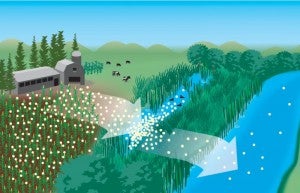Lake Erie’s fertilizer problem isn’t over, but we’re working on it
Fertilizer is the engine of agriculture, but its inefficient use means that excess fertilizer ends up in our waterways, contaminating freshwater supplies and causing algae blooms, such as those that recently cut off water supplies to hundreds of thousands of residents in Toledo, OH. In addition to impacts on communities, algae blooms also affect ecosystems, killing millions of fish and harming the seafood and recreation industries.
Nutrient runoff from fertilizer is a problem that many stakeholders, including farmers, have been trying to fix for many years, both in the Western Lake Erie Basin and beyond. The efforts to date have had a real impact, but that impact has not been nearly enough to solve the problem of dangerous and costly dead zones.
We need to do much more at a much larger scale, while also increasing productivity to feed a growing population.
Farmers as part of the solution
In the Western Lake Erie Basin, agriculture has a long history as a critical component of the region’s economy and social fabric. This agricultural history is dominated by intensified corn, soybean and wheat production. But farmers rely heavily on fertilizer to produce this bounty, and when it comes to water quality problems, the chief nutrient of concern in this basin is phosphorus.
As the U.S. Department of Agriculture’s Steve Davis told NPR, “Farmers are doing a better job than they used to of putting on the right amount, but we need to make sure it gets put on in the right place.”
Improving efficiencies in fertilizer applications is the number one priority of my work at EDF. I have worked with farmers in Ohio for many years to develop nutrient use efficiency programs designed to increase agricultural productivity while reducing nutrient losses to water and air. Together, we have developed platforms – such as the Adapt Network – for testing rates, timing and placement of nitrogen and phosphorus, as well as promoting soil health initiatives and strategic placement of landscape filters like buffers and wetlands.
 Bringing benefits to farmers and consumers
Bringing benefits to farmers and consumers
Thanks to these programs and efficiency tools, farmers in multiple states in the Midwest and East have successfully reduced fertilizer loss by an average of 25 percent on half a million acres – all while maintaining or increasing crop yields.
Fred Yoder is an Ohio farmer who advises EDF on our conservation work and is participating in one of our sustainable sourcing projects. He said the reason he works to optimize efficiency and conserve his soils is because, “fertilizer is one of my highest operating costs, so minimizing use and loss saves me money, improves the overall health of my farm and strengthens my relationship with buyers who are looking for fertilizer-efficient products. It’s just good business sense.”
The International Joint Commission lists targets for lowering phosphorus entering Lake Erie by at least 40 percent to combat algal blooms like the one that plagued Toledo’s drinking supply. If we are to going to succeed in making reductions of this kind, we’re going to need to scale up even more.
Connecting supply and demand for greater impact
EDF is now working to connect a decade’s worth of collaboration with farmers on nutrient use efficiency to a new source of demand and motivation for nutrient efficient agriculture – the supply chain.
Interest in and demand for sustainable production from major retailers and food companies offers a great opportunity to make conservation an integrated part of the business of agriculture in a whole new way, building on the good work on the ground and taking it to scale. To do this, EDF is collaborating with decision makers at every point in the supply chain – from retailers and food companies to agribusiness and farmers – to strengthen demand for nutrient-efficient products and generate supply.
Right now, EDF is collaborating with Walmart, General Mills, United Suppliers and other influential food companies, agribusinesses and grower organizations to work across supply chains to drive transformative change that will minimize nutrient losses while achieving high levels of productivity across the U.S. agricultural system.
EDF worked with Walmart to commit to a goal of reducing GHG emissions from its supply chain by 20 million metric tons by 2015. To meet that goal, Walmart has launched a fertilizer initiative that requires companies who use commodity grains to develop fertilizer optimization plans. Thus far, 15 major suppliers – representing 30 percent of food and beverage sales in North America – have developed fertilizer optimization plans.
With demand signals of this strength and scope, I am hopeful that we will see major reductions in nutrient losses across the U.S. agricultural landscape, ensuring clean, safe drinking water and cutting greenhouse gas emissions. It’s a win-win-win for farmers, consumers and the environment.













